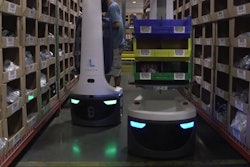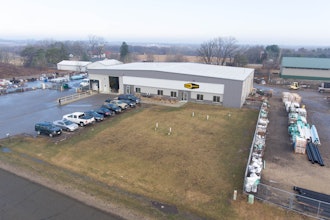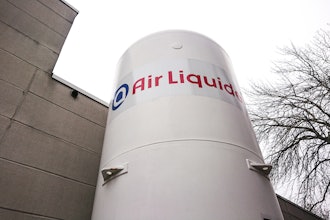Embracing the Digital Economy in the Wholesale Distribution Industry © 2017 SAP SE or an SAP affiliate company. All rights reserved.- 1 -
Embracing the
Digital Economy
in the Wholesale
Distribution
Industry
Innovate and
Thrive to Secure
Your Leadership
Position in the
Value Chain
2017 Edition
Embracing the Digital Economy in the Wholesale Distribution Industry © 2017 SAP SE or an SAP affiliate company. All rights reserved.- 2 -
Dear Customers,
Are you an innovator or a follower? Disrupter or disrupted? Growing or stagnant? Digital predator
or digital prey? The choice is yours.
Today’s competitive markets demand that wholesale distributors evolve more quickly, become
more efficient, and provide memorable customer experiences. For decades, distributors have
thrived primarily on great existing customer relationships. In the new millennium, simply breaking
bulk and having great relationships are not enough. Today, leading distributors are using digital
technology to create, deliver, and sustain new and meaningful customer experiences. If you’re
not thinking about how to incorporate technologies such as drones, 3D printing, smart vending
machines, customer-facing apps, and more into your strategy, you will be left behind.
To survive, companies must rethink business processes and models and use of their vast wealth
of data to remain relevant and leapfrog their competitors. Disrupters are making headway in
markets traditionally served by distributors, and customer and employee expectations are
changing rapidly.
Big change always comes with risk, but it also offers untold opportunity to innovators. To
capitalize on the opportunity, wholesale distributors are investing in a set of strategic priorities:
• Using value-added services to create new revenue sources – Offer services such as light
manufacturing kitting
• Becoming a real-time distributor – Deliver within hours by using drones or Uber drivers
• Providing infinite inventory – Use 3D printing in-house or at a customer location
To execute the strategic priorities, leading distributors are:
• Reimagining business models to identify and monetize new opportunities
• Reimagining business processes to optimize business outcomes by implementing bold
initiatives to completely automate core, highly administrative processes
• Reimagining the role and structure of their workforce to support their current and future
business
Reimagining business requires guts, determination, and a digital framework that underlies both
internal business processes and models as well as external customer interactions. All stakeholders
– customers, suppliers, and employees – will use digital innovation. This paper will show you how
you can begin to execute on this vision by providing examples of how you can survive in the
present and thrive in the future. This will require focusing on customer engagement opportunities,
offering new services, executing on processes that easily enable insight to action, integrating
cloud-based business networks, tapping into an extended workforce, and building the bridge to
advanced solution landscapes using new technologies.
This document offers our perspective on where the industry will go and how SAP can help in the
evolution of the digital economy. We thank you for your interest and look forward to your feedback.
Karen S. Lynch
We envision the digital
framework for wholesale
distribution as one that will
enable you to win through
innovative new business
models, simplify and
improve the way you work
with your customers and
suppliers, and enable your
employees to grow their
businesses.
Karen S. Lynch
Vice President, Global Head,
Wholesale Distribution Industry
Business Unit
SAP
KAREN’S POINT OF VIEW
Embracing the Digital Economy in the Wholesale Distribution Industry © 2017 SAP SE or an SAP affiliate company. All rights reserved.- 3 -
TABLE OF CONTENTS
The Big Picture
The Digital Economy
Executive Summary
4
5
4
Reimagining
Reimagine Business Models
Reimagine Business Processes
7
8
6
Reimagine Work 9
Digital Business Framework
Digitalization Across Key Pillars
SAP Portfolio for a Digital Business Framework
Digital Platform Enables Critical Business Capabilities
11
12
13
10
How Does It All Come Together? 14
From Your Current State to Digital
Transforming from Your Current State to Digital
SAP Digital Business Services
SAP Comprehensive Ecosystem
16
17
18
15
Why SAP?
SAP Is Committed to Innovation 20
19
Additional Resources
21
Embracing the Digital Economy in the Wholesale Distribution Industry © 2017 SAP SE or an SAP affiliate company. All rights reserved.- 4 -
THE BIG PICTURE
The digital economy is real and will continue to transform wholesale distribution business.
The digital economy
Three technology trends are shaping the digital economy – artificial intelligence and machine
learning, augmented reality, and the Internet of Things (IoT). The pace of change is staggering.
In the next 10 years, 40% of the S&P 500 will no longer exist if they do not keep up with these
technology trends.1 Leading wholesale distributors are preparing to use digital tools to find new
answers to questions such as:
• What are the profitable new business models and trends in marketplaces, 3D printers, drones,
smart vending, and data science?
• How do we capitalize on the demand for more and new services in a hyperconnected world?
• Which trends and technologies from adjacent industries are influencing distributors (retail,
consumer products, and life science manufacturers)? And, does it matter, or are the new
market disrupters the real threat?
Disrupters are emerging quickly and from unexpected places
The wholesale distribution industry boundaries are already blurred. Large players such as
Amazon, Alibaba, and others provide personalized, business-to-consumer (B2C)–like services
that customers have come to expect. Key questions include:
• How do we ensure that our customers are at the center of everything we do, and how do we
sustain and grow customer relationships with new digital services?
• Which market spaces are most attractive for new disruptive competitors, and how do we defend
our position and win or keep the business?
• Who are the right partners on our journey?
Aware but unsure
Executives know the world has changed. Research shows 90% of CEOs believe the digital
economy will have a major impact on their industry, but only 25% have a plan in place, and less
than 15% are funding and executing on the plan.1
Early adopters are winning
Companies that embrace the digital world and execute on a digital strategy grow shareholder and
stakeholder value faster than their peers. The nature of the digital framework forces participants
to synchronize and collaborate to deliver quality products at a fair price, at the exact moment the
customer needs them, with the value-added services they expect. Wholesale distributors are
focusing on the business segments that allow market leadership and differentiation. They are
able to understand which tasks are better allocated to a partner in their network and are able to
continuously adapt to changing market conditions.
Digital business
models are disruptive.
The rules have changed.
• Fastenal boosted its FAST
Solutions vending total 15.7% to
50,620 smart vending machines
for the quarter compared to the
same quarter a year ago. “The
vending machine is a sign of
engagement with your customer.
If you are truly engaged with your
customer, you should be able to
put vending machines out there,
and it makes the business
stickier.”2
• National DCP is an exclusive
cooperative for more than 8,000
Dunkin’ Donuts establishments
that recently implemented a
number of SAP solutions. “This
was an unprecedented amount
of change at one time, touching
every system, every process, and
the underlying platform. At the
same time, it was the fastest
way to accelerate our business
progress with the least amount
of risk from a technology
perspective.”3WHAT DOES THIS TELL US?
The road map to relevance is to reimagine business models and
proactively evolve before new digital competitors emerge. Leading
distributors are:
• Reinventing and digitalizing the business
• Cooperating with partners to achieve economies of scale
• Digitalizing engagement with customers
Today, every business is a technology business.
Access more information
on the latest technology
trends here:
Embracing the Digital Economy in the Wholesale Distribution Industry © 2017 SAP SE or an SAP affiliate company. All rights reserved.- 5 -
REIMAGINING
Do you have the right strategy? Start by reimagining your business, with business outcomes and customers at the center.
Reimagine business models to drive competitive advantage by expanding beyond traditional boundaries. Reimagine business processes
to dramatically change the way you can do business. Reimagine work based on real-time information to make the right decisions and
drive immediate impact.
EXECUTIVE SUMMARY
The Future: Strategic priorities for wholesale distributors
US$50 billion
In incremental revenue is available
through simplification in the United
States, the United Kingdom, and
Germany combined4
36
Enterprise apps per billion dollars in
revenue for the average company.
This is driving most of the technical
complexity.6
81%
Believe simplification is important
for their organization, and 88%
admit IT investment is important
to achieve simplification5
1. Using value-added services to create new revenue sources – everything from light manufacturing and
kitting, to ad-hoc virtual training, to automated tracking of sensors for maintenance, to predicting
future demand patterns based on long-term weather forecasts
2. Becoming a real-time distributor by using drones or Uber drivers to deliver within hours. Use
predictive analytics to track demand patterns and recommend order items and quantities.
Incorporate social media feeds into your customers’ apps for immediate feedback from their
customers on processes and programs.
3. Providing infinite inventory by using 3D printing in-house or at a customer location. Master the art
of spot buying to provide an infinite catalog of products. Make full use of the business network to
become the master distributor for a group of products or geography.
In today’s competitive marketplace, it is essential to focus on the right strategic priorities to drive digitalization across the business.
Distributors must reinvent themselves from a warehouse of products for serving demand to information-centric companies that utilize
new business models to gain competitive advantage. It will no longer be possible to survive by simply breaking bulk. Working with
leading companies across the globe, we see investments around three strategic priorities.
Successfully embracing the opportunities from new technologies and consequently addressing these three strategic priorities will be
the foundation of successful digitalization and staying ahead of the innovation curve.
Embracing the Digital Economy in the Wholesale Distribution Industry © 2017 SAP SE or an SAP affiliate company. All rights reserved.- 6 -
REIMAGINING
THE DIGITAL ECONOMY OFFERS
INFINITE OPPORTUNITIES
In a connected world where every company is becoming a
technology company, smarter products and services will refocus
commerce on business outcome and blur industry lines.
SAP Digital Economy in the Wholesal Distribution Industry Whitepaper (mm/17) © 2017 SAP SE. All rights reserved
Embracing the Digital Economy in the Wholesale Distribution Industry © 2017 SAP SE or an SAP affiliate company. All rights reserved.- 7 -
REIMAGINE BUSINESS MODELS
REIMAGINE EVERYTHING
Distributors must reinvent themselves from a warehouse of products for serving demand to information-
centric companies that utilize new business models to gain competitive advantage. It will no longer be
possible to survive by simply breaking bulk and having great legacy customer relationships. The time to
digitally transform is now.
Value-added services distributors
For years, most distributors have been providing value-added
services, many of which have been free of charge. Leading
distributors will take these value-added services to the next
level and use them to significantly increase revenue and
bottom-line profitability. Consider providing your customers
with a menu of a la carte options, such as:
• Light manufacturing and kitting on orders
• Ad-hoc virtual training for restaurant operators on how to
prepare new entrees to installing and maintaining equipment
• Sensors embedded by the manufacturer in products that will
notify your customers of their own customers’ equipment
downtime
• Predicting future demand patterns based on long-term
weather forecasts and recommendations on reorder
quantities based on this information
• Acting as a financial institution by providing lending services
Infinite inventory distributor
By becoming an infinite inventory distributor, you will
significantly reduce inventory carrying costs yet still give your
customers access to an unlimited number of products and
services.
• Use 3D printing in-house to print nonstock parts, or give your
customers a 3D printer and sell them the specs so they can
print parts in-house, on demand. The specs can be limited by
the number of prints or a certain time frame
• Effectively use spot buying to provide an infinite catalog of
products
• Become the master distributor for a group of products or for
a geography by fully leveraging the business network
Real-time distributor
All customer touch points can and will be in real time: logistics,
ordering, payment, marketing through social media, and even
training.
• Use drones or Uber drivers to deliver orders within hours, not
days
• Use up-to-the-minute predictive analytics to track demand
patterns and automatically recommend order items and
quantities
• Incorporate social media feeds into your customers’ apps
for up-to-the-minute feedback from their customers on
processes and programs
• Install smart vending machines at your customers’ locations
or job sites so they can access what they need when they
need it
NEW TECHNOLOGIES
Prime Air – a future delivery system from Amazon
designed to safely get packages into customers’
hands in 30 minutes or less using drones 7
SUPERIOR CUSTOMER EXPERIENCE
Fastenal has 50,000 industrial vending devices
installed at customer sites. Vending has quickly
become a core part of Fastenal's business and an
important growth driver.8
Embracing the Digital Economy in the Wholesale Distribution Industry © 2017 SAP SE or an SAP affiliate company. All rights reserved.- 8 -
REIMAGINE BUSINESS PROCESSES
Any business process can and will be modernized and digitalized. The time to plan and execute is now.
REIMAGINE EVERYTHING
Ingram Micro achieved 50% greater
business-to-business order entry
utilization in specific channels10
8%–14% sourcing savings with
integrated strategic sourcing and a
supplier management solution9
OPPORTUITY TO CASH
Exceptional customer experiences
Become easier to do business with. Provide a vast variety of
ordering channels from call centers, Web sites, text messages,
and in-person interaction to deliver the exact products and
services your customers need when they need them. The
customer experience today constitutes a lifecycle, not just
an interaction restricted to the front end of the enterprise.
Customers expect a consistent experience during each and
every touch point with your organization.
PROCURE TO PAY
Business networks for goods and services
Predefine suppliers, pricing, safety stock, or reorder points to
enable touchless and automated processing. Automation of
these highly manual processes will enable employees to focus
on customer-centric activities, which will help to improve
loyalty and ultimately increase sales.
PROFITABILITY OPTIMIZATION
Predictive analytics
Data should be used to forecast and predict, not
reminisce. Enable the business to react to trends in real
time. Imagine being able to tell your customers which
products they will need and when they will need them,
well before they are even aware of a potential shortage.
Customer insight and segmentation
Segmentation and stratification of your customer base and
those individuals within the customer base who interact with
you will transform marketing, personalization, and customer
loyalty. This will enable you to focus on improving and
nurturing relationships with your most profitable customers,
and to take insight-driven action to improve business
operations with your least profitable customers.
Cost recovery and rebates
Negotiate the best deals with suppliers to increase margin,
optimizing chargebacks, pricing, and inventory levels. Handle
complex, high-volume financial processing in your own
company or as a service for business partners. Today, many
companies are leaving significant revenue on the table, as
rebate and chargeback processes are still manual. With digital
solutions, the process can be completely automated to ensure
that every opportunity to collect is captured.
Embracing the Digital Economy in the Wholesale Distribution Industry © 2017 SAP SE or an SAP affiliate company. All rights reserved.- 9 -
Employer-of-choice status goes beyond recruitment and retention – to fundamentally revolutionizing the
way people engage with peers, customers, other business partners, and the organization itself.
REIMAGINE WORK
Every substantial business transformation automates manual
tasks, enriches jobs, and drives efficiency.
Eliminate work all together by digitalizing manual steps in the
process (for example, invoice and payment processing). This
will enable your employees to focus on true value creation and
customer service. It will also enable you to reallocate your
employees to tasks and responsibilities that are more customer
focused and customer facing, to help drive additional revenue
and bottom-line results.
Improve productivity and profitability by enabling users to
access the right information at the right time on any device.
Employees will have immediate access to what they need, when
and where they need it, to quickly and easily complete simple
and complex tasks.
Employ a flexible, lower-cost workforce to address customer
demands in real time by onboarding part-time, temporary
workers to fill gaps or spikes in business demands. This
contingent workforce can be used to provide additional
services to customers if and when you don’t have the skills
in-house. For example, a temporary service technician can
be called upon to train your customers on how to service
and maintain equipment they have purchased from you.
People continue to be key assets in the wholesale
distribution digital economy. Their roles will change,
but their value to each area of the business will grow.
Al-Futtaim has realized $433,232 in savings to date by
delivering learning online.11
As the wholesale trade sector can expect a substantial exodus
of workers in the forthcoming years, employers may face
tensions in matching workers to jobs. This may require
rethinking longstanding workplace practices.12
REIMAGINE EVERYTHING
Use predictive and self-learning software to improve
collaboration, productivity, and engagement to optimize
business decisions. Employees will have the power to learn on
demand, enhance their skills, and become more productive
and effective.
Use interactive technology to improve user experiences,
including voice recognition, visualization, and gaming. The lines
between work and personal experience have blurred, so enable
your employees to use the tools and technology at work in
much the same way they use them at home.
Embracing the Digital Economy in the Wholesale Distribution Industry © 2017 SAP SE or an SAP affiliate company. All rights reserved.- 10 -
DIGITAL BUSINESS
FRAMEWORK
A SIMPLE AND PROVEN
APPROACH TO VALUE CREATION
THROUGH DIGITALIZATION
Every company in the wholesale distribution industry requires
a simple digital approach to build a pragmatic and executable
vision on its digital strategy.
Embracing the Digital Economy in the Wholesale Distribution Industry © 2017 SAP SE or an SAP affiliate company. All rights reserved.- 11 -
1. Ensure premium, consistent customer service across all
channels with new insight-based business models.
2. Attracting and retaining a talented workforce is vital.
As business models change, skills can be supplemented
with contingent workers to meet new and unique business
requirements.
3. The IoT and supply chain fuels new business models such
as predictive maintenance and more-efficient energy
consumption at all locations. This simplifies collaboration
with suppliers and eliminates errors from business tasks
such as invoicing, creating RFPs, order processing, and
supplier selection. Forecasts will be more accurate, and
it provides opportunities to create new sales channels.
4. Business networks allow management of the entire
analyze-to-contract process and can drive significant
sourcing savings, effectively managing contracts and
collaborating more efficiently with suppliers – all while
helping ensure compliance.
Wholesale companies are looking to address the digital
convergence across B2B and B2C. By realizing the importance
of integrating workflows and technology to address each of the
digital pillars – customer, supplier, workforce core business
processes, business networks, and the IoT – leading wholesale
distributors are transforming, reengineering, and finding hidden
ROI within their business. Each of these digital pillars plays a
vital role in harnessing the profit from dynamic, savvy, and
empowered consumers that are masters of the marketplace.
Every wholesale distributor needs to think about digitalization across key pillars.
DIGITAL BUSINESS FRAMEWORK
This concept, which is often referred to as “bimodal IT,” is brought
to life through the digital business framework methodology at SAP,
pictured below.
The digital core is the foundation for the core enterprise processes,
which need to run consistently and uninterrupted. It provides real-
time transactions and analytics, the ability to work with Big Data, and
connectivity to the outside pillars of the framework.
Embracing the Digital Economy in the Wholesale Distribution Industry © 2017 SAP SE or an SAP affiliate company. All rights reserved.- 12 -
SAP PORTFOLIO FOR A DIGITAL BUSINESS FRAMEWORK
SAP has innovated its portfolio to provide both for a stable digital core as well as
flexible line-of-business (LoB) extensions.
In the digital economy, simplification and business innovation matter more than ever. To do this effectively, it’s important to cover the
entire digital transformation journey, ranging from planning a digital innovation road map and implementation plan with proven best
practices to the ability to run all deployment options and ultimately optimize for continuous innovation with a focus on outcomes.
Processes are designed from the outset to flow end to end across the cloud-based solution extensions, listed in the white bands in the
image below, and are fully integrated to SAP S/4HANA Enterprise Management and are optionally deployed to address business needs.
The solution capabilities in the dark blue band below, the digital core, are delivered as part of SAP S/4HANA Enterprise Management.
The capabilities in the lighter blue band, also in the digital core, are part of SAP S/4HANA Enterprise Management but added on as
needed.
D
ig
it
a
l
C
o
re
Enterprise Management
• In-memory computing cloud for marketing
• Cloud solutions for customers
• Cloud solutions for sales
OPPORTUNITY TO CASH
• Sales planning and performance
management (ICM)
• Order and contract management
• Strategic sourcing and supplier
collaboration
• Business network
• Guided end-user buying
• External workforce management
PROCURE TO PAY
• Operational purchasing
• Collaborative sourcing and contract management
• Invoice and payables management
• Supplier management
• Procurement analytics
• Core human resources and payroll
• Talent management
• Time and attendance management
• Human capital analytics
• Time recording
HUMAN RESOURCES
• Integrated business planning
• Global batch traceability
• Extended warehouse management
• Transportation management
• Extended warehouse management
• Available to promise
• Inventory management
• Basic warehouse management
• Production planning
SUPPLY CHAIN PLANNING AND EXECUTION
• Cost recovery and rebates
• Supplier collaboration
• Business network
• Guided end-user buying
PROFITABILITY OPTIMIZATION
S
A
P
L
e
o
n
a
rd
o
SAP HANA® | SAP Cloud Platform
• Customer insight and segmentation
• Procurement insight
• Logistics network
• Cost recovery and rebates
• Governance, risk, and compliance
• Financial services network
• Accounting and closing operations
• Accounting
• Cost management and profitability analysis
FINANCE AND GENERAL TRADING
• Financial planning and analysis
• Accounting and financial close
• Treasury management
• Accounts receivables and payables, invoices
Learn more about SAP solutions today and
discover planned innovations by accessing the
SAP road map for whole sales distribution here:
• Order optimization and vendor discounts
• Settlement Management
Value-added
services
distributors
• Streamline marketing operations by giving
employees the insight they need to
understand customer needs
• Deliver the right order – right on schedule –
by collaborating enterprise-wide in real time
• Coordinate marketing activities across
channels
• Boost delivery performance with embedded
logic that automatically matches supply of an
ordered item with demand
• Manage the entire analyze-to-contract
process
• Streamline sourcing processes
• Improve source determination for direct
materials
• Mitigate risk and enhance compliance with
standardized contract-management
processes
• Streamline material flows, support customer
communication and collaboration, and make
warehouse operations more transparent
• Govern and analyze demand streams and
feed them into operational planning
• Automate and tightly control the purchasing
process through catalog-driven pricing,
contract logic, and an approval workflow
• Enable complete visibility into inventory
• Use live calculation of key performance
indicators to analyze spend, contracts, and
suppliers
• Aggregate disparate spend data, analyze it
for new insights, and share new intelligence
• Capture agreement and transaction data,
manage claims, and control agreements –
from initiation to settlement
• Manage chargeback and rebate programs
• Unify all customer and market data into a
single view
• Attract and retain the best employees
• Utilize a flexible, lower-cost workforce to
address customer demand
• Simulate and analyze scenarios to
evaluate financial implications of
strategic business choices
• Manage customer portfolios strategically
• Incorporate payment models for digital
services into product calculation and financial
reporting
• Oversee compliance
• Optimize working capital
Real-time
distributor
• Deliver real-time offers with real-time views of
customer feedback
• Plan and execute targeted, multichannel, and
multiwave campaigns with dynamic content
personalized based on customer behavior
• Give internal sales with relevant insights,
contacts, and collaboration
• Prioritize customers through business rules
for
back-order processing
• Provide near-real-time visibility into
organizational spend and suppliers
• Drive sourcing savings, manage contracts,
and collaborate with suppliers
• Integrate barcode and RFID technology into
outbound processes to manage just-in-time
availability, unit handling, serial numbers,
electronic data interchange, and proof of
delivery
• Monitor the supply base to provide actionable
intelligence and insights into supplier risk
• Take advantage of real-time analytics to
better address orders, invoices, inventory,
and costs
• Streamline vendor selection, sourcing
negotiation, performance measurement, and
invoicing
• Integrate processes for sales, inventory, and
operations
• Match supply to demand across the supply
network
• Gain real-time visibility into spend data,
suppliers, and orders
• Connect and collaborate with the logistics
network to comply with regulations
• Gain a 360-degree view of the customer with
real-time profiles that track context, interests,
and predictive scores
• Enable employees to make decisions in real
time on any device
• Use predictive and self-learning software to
improve collaboration, productivity, and
engagement to optimize business decisions.
• Social media
• Mitigate increased financial risks
associated with highly flexible
supply chains
• Analyze profits across multiple
dimensions such as product groups,
customers, projects, profit centers, and
warehouses
Infinite
inventory
distributor
• React quickly to market opportunities with
real-time market and performance insights
• Increase collaboration among internal and
external teams
• Provide status of mass-product availability to
plan sales and production orders
• Optimize marketing across channels,
customers,
and content
• Engage your customers in a contextual
experience
• Use a dynamic, centralized platform for
supplier management
• Streamline material flows and transparency
across end-to-end inbound logistics
operations
• Automate warehouse operation processes
• Improve asset utilization, help ensure on-time
and accurate order fulfillment, and manage
transportation costs
• Manage transportation requirements by
planning, optimizing, tendering, and settling
freight; booking carriers; managing forwarding
orders; and complying with international trade
and hazardous goods requirements
• Automate warehouse and distribution
operations
• Perform allocation management, order
promising, replenishment, deployment, and
manufacturing network planning
• Anticipate customer behavior with predictive
analytics
• Gain a holistic understanding of the market’s
voice by systematically monitoring structured
and unstructured data from call centers,
e-mails, social media, and other channels
• Align employee performance and goals to
create an engaged and high-performing
workforce
• Provide employees with on-demand learning
to improve skills and productivity
• Support financing and management of
the risk of assets that are operated for
customers through a product-as-a-service
contract
• Control the finances of performance-
based service contracts
Wholesale distribution companies need to reimagine business models and business processes to find new revenue and profit sources by:Digitally reimagine
your business
models through
new business
capabilities along
a value map. Opportunity to Cash Procure to Pay
Supply Chain Planning and
Execution
2. Addressing operational inefficiencies proactively and impacting bottom-line results
while becoming easier to engage in business
1. Reinventing the business from a warehouse of products fulfilling demand to an information-centric
company that uses new business models to gain competitive advantage
Profitability Optimization Finance and General Trading
[email protected]
Human Resources
• Customer satisfaction: +10%–
20%
On-time delivery: +10%–30%
• Inventory levels: -25%–30%
• Supply chain planning: -3%–5%
• Order fulfillment issue resolution: -50%
• Revenue loss due to stock-outs:
+10%–15%
• Days in inventory: - +10%–12%
• Total logistics cost: -10%–12% • Employee turnover: -32%
• Revenue per worker: +20%
Typical
business
benefits*
*)B
e
n
e
fits
a
re
b
a
s
e
d
o
n
e
a
rly
a
d
o
p
te
rs
o
f S
A
P
S
/4
H
A
N
A
o
r c
o
n
s
e
rv
a
tiv
e
o
u
ts
id
e
-in
b
e
n
e
fits
d
u
e
to
m
o
v
in
g
fro
m
a
tra
d
itio
n
a
l E
R
P
to
e
n
h
a
n
c
e
d
S
A
P
S
/4
H
A
N
A
a
n
d
L
O
B
/c
lo
u
d
c
a
p
a
b
ilitie
s
.
• Order optimization and vendor
discounts
• Settlement Management
Digital
Innovation
SAP Leonardo
Extensions
Digital Core
SAP S/4HANA
SAP Cloud Platform Analytics Services Mobile Services Security Services Collaboration Services UX Services
▪ In-memory computing cloud for marketing
▪ Cloud solutions for customers
▪ Cloud solutions for sales
▪ Sales planning and performance
management
▪ Order and contract management
Opportunity to cash
▪ Core human resources and payroll
▪ Talent management
▪ Time and attendance management
▪ Human capital analytics
• Time recording ▪ Accounting and closing operations
▪ Accounting
▪ Cost management and profitability
analysis
▪ Strategic sourcing and supplier collaboration
▪ Business network
▪ Guided end-user buying
▪ External workforce management
Procure to Pay Supply Chain Planning and Execution
• Customer insight and segmentation
• Procurement insight
• Logistics network
• Cost recovery and rebates
Profitability Optimization
▪ Financial planning and analysis
▪ Accounting and financial close
▪ Treasury management
▪ Accounts receivables and payables, invoices
▪ Governance, risk, and compliance
▪ Financial services network
Finance and General Trading
▪ Operational purchasing
▪ Collaborative sourcing & contract management
▪ Invoice and payables management
▪ Supplier management
▪ Procurement analytics
• Cost recovery and rebates
• Procurement
• Supplier collaboration
• Business network
• Guided end-user buying
▪ Cost recovery and rebates
▪ Procurement
▪ Supplier collaboration
▪ Business network
▪ Guided end-user buying
▪ usto er insight and seg entation
▪ rocure ent insight
▪ istics t rk
▪ ost recovery and rebates
▪ Order optimization and vendor discounts
▪ Settle ent manage ent
Human Resources
▪ Core human resources and payroll
▪ Talent management
▪ Time and attendance management
▪ Human capital analytics
Profitability Optimization
▪ i r r i
• Integrated business planning
• Extended warehouse management
• Transportation management
▪ Global batch traceability
• Extended warehouse management
• Available to promise
▪ Inventory management
▪ Basic warehouse management
▪ Production planning
▪ Extended warehouse management
▪ Available to promise
▪ Integrated business planning
▪ Extended warehouse management
▪ Transportation management
▪ Resume matching
▪ Job matching
▪ Invoice matching
BlockchainMachine Learning Big DataInternet of Things Analytics
Embracing the Digital Economy in the Wholesale Distribution Industry © 2017 SAP SE or an SAP affiliate company. All rights reserved.- 14 -
HOW DOES IT ALL COME TOGETHER?
Example: The process flow described on this page portrays
how leaders in the wholesale distribution business can integrate
their operational technology and information technology to
better serve their customers. These two technology platforms
are typically owned and operated by two different parts of the
business. In the new digital framework, the value will come from
the interoperability of these environments.
In this example, a sensor was embedded in a pump during the
manufacturing process. Because the distributor has collected
the data from the sensor, a service technician can now be
signaled, through text message, that the pump is
malfunctioning.
The service technician can view, on any device, where the
malfunctioning pump is located, and then evaluate whether to
repair or replace the pump based on labor hours and total cost.
He determines that the pump needs to be replaced, so he visits
the distributor’s Web site to order a new pump.
While each of the digital business pillars delivers significant value as a stand-alone capability, the ultimate goal is to
design the next generation of business processes that will span across all the digital pillars. Customer experience will
not stop at the channel experience. Supply chain and services have to be aligned with the customer experience
strategy if products and services are to be delivered as promised.
It becomes clear during the ordering process that the customer
needs assistance, so the distributor’s customer service agent
launches an online chat. The right pump is selected and
ordered for next-day delivery. Since this pump is not stocked
at the distributor, a spot buy from a preapproved supplier is
executed with a dropship to the customer’s location.
As the service technician begins to install the new pump, he
quickly recognizes that he needs assistance. He scans the QR
code on the pump and is directed to the distributor’s site where
he sees, in specific detail, the step-by-step process required to
install the new pump.
The benefits of this scenario are significant:
• Increased customer satisfaction and loyalty
• Zero downtime for the distributor’s customer
• Higher productivity
• New services and new revenue streams
Use sensor data, omnicommerce, and business networks to provide customers with the exact
product they need when the existing product is at the end of its lifecycle.
Business networks
Workforce
engagement
IoT and supply
chain
Digital core
Watch a video illustrating
this example here:
Install
replacements
Create
work order
Pick, pack, ship
and invoice
order
Spot pay of
replacements
part to fulfill
order
Search online
for best
product
Notify
customer
Collect
sensor data
Determine need
for product
replacement
Collaborate with
sales rep on
product
Embracing the Digital Economy in the Wholesale Distribution Industry © 2017 SAP SE or an SAP affiliate company. All rights reserved.- 15 -
FROM YOUR
CURRENT STATE
TO DIGITAL
The journey to becoming a digital
distributor begins with planning a
digital transformation road map.
Embracing the Digital Economy in the Wholesale Distribution Industry © 2017 SAP SE or an SAP affiliate company. All rights reserved.- 16 -
In the digital economy, simplification and business innovation matter more than ever. To do this effectively, it’s important to cover
the entire digital transformation journey, ranging from planning a digital innovation road map and implementation the plan with
proven best practices to the ability to run all deployment options and ultimately optimize for continuous innovation with a focus
on outcomes.
TRANSFORMING FROM YOUR CURRENT STATE TO DIGITAL
The keys to success
To move forward with speed and agility, it helps to focus on live digital data, instead of Big Data, and combine solution know-how
and industry-specific process expertise with data analytics so that the right digital reference architecture is defined and delivered.
In that context, we believe that a model company approach is very relevant to enable you to transition from your current state to
digital. Model companies represent the ideal form of standardization for a specific line of business or industry. They are built on
existing SAP solutions using best-practice content, rapid prototyping solution packages, and additional content from customer
projects. They provide a comprehensive baseline for rapid and customer-specific prototypes, cloud demos, and quick-start
implementations.
BUILD AND LAUNCH
with proven best
practices
Standardize and innovate
• Model company approach
to accelerate adoption with
model industry solutions
• Design thinking and rapid
tangible prototypes
• Coengineered industry
innovations delivered with
agility
PLAN
well to manage
expectations
Simplify and innovate
• Reimagined business
models, business
processes, and work
• Digital business framework
as a guide for digital
transformation
• Value-based innovation
road maps
RUN
all deployment
models
Run with one global support
• One global, consistent
experience
• Comprehensive support –
on premise, in the cloud,
or a hybrid approach
OPTIMIZE
for continuous
innovation
Optimize to realize value
• Continuously capture and
realize benefits of digital
transformation
The end-to-end digital transformation journey
Model Company Approach
Social
networks
Business
networks
Internet
of Things
Big Data
Devices
People
End-to-end solution
Innovation
Differentiation
Best practice SAP products
Model company
End-to-end business process
Embracing the Digital Economy in the Wholesale Distribution Industry © 2017 SAP SE or an SAP affiliate company. All rights reserved.- 17 -
SAP has a broad range of services to cover the end-to-end
digital transformation journey, ranging from advising on a
digital innovation road map and implementation
plan with proven best practices to the ability to run all
deployment options and ultimately optimize for
continuous innovation. We provide both choice and value
within our service offerings, allowing you to tailor the
proper approach based on your specific company
expectations and industry requirements.
SAP DIGITAL BUSINESS SERVICES
Enabling your success in digital transformation
From proposing a comprehensive digitalization proposal to realizing and running it, SAP delivers on the digital transformation promise
to its customers – on time, within budget, and on value.
SAP value delivery relies on unique differentiating assets.
Digital Business Foundation Business Insights Continuous Improvement
• Digital boardroom
• Predictive customer insights
• Value realization dashboard
• Agile decision making and
execution support
• Joint value governance
• Sustainable engagement model
• Innovation without disruption
• Simplification
• Digital business model
• Flexible, scalable enterprise
architecture
• Platform for the digital future
• People and culture transformation
The SAP Digital Business Services organization delivers digital innovation with simplification and accelerated implementation,
which is key to adoption and value realization. Continuous improvement is supported through ongoing assessment of real-life
data insights and joint governance with customers.
SAP value delivery focuses on the following deliverables.
SAP Activate methodologyExhaustive service
portfolio
SAP Solution
Manager
SAP Model company SAP Mission
Control Center
• 25,000 professionals in 70 countries
• Customers in 130 countries
• Outcomes delivered as one team in one contract
• Projects connected in real time to a global network of support
functions through SAP Mission Control Center
• SAP MaxAttention™ and SAP ActiveEmbedded services to
safeguard investment
• Consistent experience – on premise, cloud, or hybrid
• Standardized adoption of processes and tools
• Streamlined onboarding and ramp-up of stakeholders
Expert
organization
Global reach Partner
ecosystem
Industry
expertise
Focus on business
outcome
Co-innovation
Run better:
Operate
Use better:
Harvest
Extend use:
Invest
Build new:
Innovate
Corporate
Strategy
Embracing the Digital Economy in the Wholesale Distribution Industry © 2017 SAP SE or an SAP affiliate company. All rights reserved.- 18 -
Our comprehensive ecosystem for the industrial
machinery and components industry offers:
• Integration into a wide range of business services
(suppliers, banks, key vendors, travel, and more)
• Open architecture, with a choice of hardware and
software
• Complementary and innovative third-party solutions
• Reach – partners to serve your business of any size
anywhere in the world
• Forum for influence and knowledge
• Large pool of industry experts with broad and deep
skill sets
SAP COMPREHENSIVE ECOSYSTEM
Orchestrating the world to deliver faster value
DRIVING
CUSTOMER
VALUE
BUSINESS NETWORK
• 1.8 million suppliers
• 200 major travel partners (air, hotel, car)
• 50,000 service and contingent labor providers
IMPLEMENTATION
SERVICES
• 1,100+ services partners focused
on industrial machinery and
components
• 3,200 services partners overall
• Delivering 20+ wholesale-specific
solutions
PLATFORM AND
INFRASTRUCTURE
• 500+ wholesale cloud partners
• 1500+ platform partners
CHANNEL AND SME
• 950+ wholesale channel
partners
• 4,800 overall channel partners
INNOVATION
• 1,900+ OEM solution partners
to extend SAP solutions
• 2,000 startups developing
SAP HANA apps
INFLUENCE FORUMS
AND EDUCATION
• 32 user groups across all regions
• 40+ industry councils
• SAP community with >24 million
unique visitors per year
• 1,800 SAP University Alliances
Embracing the Digital Economy in the Wholesale Distribution Industry © 2017 SAP SE or an SAP affiliate company. All rights reserved.- 19 -
WHY SAP?
SAP has the vision, the solutions,
and the commitment to go with you
all the way – from defining your
digital strategy to delivering the
right solutions to running your
digital backbone in the cloud.
- 19 -
Embracing the Digital Economy in the Wholesale Distribution Industry © 2017 SAP SE or an SAP affiliate company. All rights reserved.- 20 -
SAP IS COMMITTED TO INNOVATION
Vision
Mission
Strategy
Help the world run better and improve people’s lives
Help our customers run at their best
Become the cloud company powered by SAP HANA
GLOBAL
PRESENCE
AND
RELEVANCE
INDUSTRY
AND LOB
FOCUS
DIGITAL
ECONOMY
READY
INNOVATION
LEADER
INTERNET OF
THINGS
ENABLED BY
SAP
• 82,000 employees
representing 120
nationalities
• 335,000 customers
• Operating in
190 countries
• Solutions for
25 industries
and 12 LoBs
• 98% of most
valued brands
as customers
• 76% of the world’s
transactions
managed on
SAP software
• 120 million
business cloud
users
• 1.9 million
connected
businesses
• More than
$800 billion in
B2B commerce
• More than 99%
of mobile devices
connected with
SAP messaging
• 2011 SAP HANA
launched
• 2012 SAP Cloud
launched
• 2014 SAP business
networks are the
largest marketplace
in the world
• 2015 SAP HANA
Cloud launched
• 2016 SAP S/4HANA:
Most modern ERP
system
• 99% of the
wholesale
distributors in the
Forbes 2000 are
SAP customers
• Our customers
distribute more than
78% of the world’s
food and more than
76% of the world’s
healthcare products
BETTER SERVICE THROUGH IMPROVED
INSIGHT
To accelerate growth and give customers what they
want when they want it, Avnet needed improved insight
into its data. With SAP Business Warehouse powered
by SAP HANA, Avnet is bringing its solutions to market
faster, allowing its customers to do the same, while
achieving a 4:1 data compression rate and simplifying
its IT landscape. Brian Chan, Vice President of IT, says,
“We are paving the way to provide Avnet with game-
changing analytics that accelerate the success of
our customers.”13
Embracing the Digital Economy in the Wholesale Distribution Industry © 2017 SAP SE or an SAP affiliate company. All rights reserved.- 21 -
1. SAP Benchmarking.
2. “Vending Growth Underscores Fastenal's Focus,”
Modern Distribution Management, July 2015,
www.mdm.com/blogs/1-management
-strategy/post/34034-vending-growth
-underscores-fastenals-focus.
3. Rise and Shine: ”Project Freshstart” Energizes
Distributor, Darrell Riekena, CIO, National DCP,
www2.deloitte.com/content/dam/Deloitte/global
/Documents/Technology/gx-cons-tech-sap
-national-dcp-distributor-supply-chain.pdf.
4. S+G Global Brand Simplicity Index 2013
www.rankingthebrands.com/PDF/Global
%20Brand%20Simplicity%20Index%202013
,%20Siegel%20plus%20Gale.pdf.
5. SAP Benchmarking.
6. SAP investor presentation, November 2015,
www.sap.com/content/dam/site/investors/assets
/2015/sap-2015-11-05-debt-call-presentation.pdf.
7. “Amazon Drone Delivery: Watch How Prime Air
Could Work,” Robotics Trends, December 2015,
www.roboticstrends.com/article/amazon_drone
_delivery_watch_how_prime_air_could_work/fun.
8. “Fastenal Now Has 50,000+ Industrial Vending
Devices Installed at Customer Sites,” August 2015,
http://investor.fastenal.com/releasedetail.cfm?R
eleaseID=927626.
9. SAP Benchmarking.
10. “Ingram Micro Mobility: Improving the Customer
Experience and Increasing Revenue with SAP
Hybris Commerce Suite,” SAP Business
Transformation Study, April 2015,
www.hybris.com/medias/sys_master/root/h0a
/hc4/8813497417758/BTS-Ingram-Micro-EN.pdf
?campaigncode=undefined.
11. Al-Futtaim: Providing Anytime, Anywhere
Learning with SuccessFactors® Learning,
SAP Business Transformation Study,
https://d.dam.sap.com/a/ynmPnA/Al-
Futtaim_BTS_Q115.pdf.
12. Talent Pressures and the Aging Workforce:
Responsive Action Steps for the Wholesale Trade
Sector, Stephen Sweet, PhD and Marcie Pitt-
Catsouphes, PhD, The Sloan Center, page 3,
www.bc.edu/content/dam/files/research_sites
/agingandwork/pdf/publications/TMISR08
_Wholesale.pdf.
13. Avnet: Delivering to Customers More Quickly with
SAP HANA, SAP Business Transformation Study,
September 2015,
www.sap.com/documents/2015/09/8ecdc66d-
437c-0010-82c7-eda71af511fa.html.
Note: All sources cited as “SAP” or “SAP
Benchmarking” are based on our research with
customers through our benchmarking program
and other direct interactions with customers
Note: Some images are used under license from
Shutterstock.com.
ADDITIONAL RESOURCES
Outlined below is additional external research that was used as supporting material
for this white paper.
Embracing the Digital Economy in the Wholesale Distribution Industry © 2017 SAP SE or an SAP affiliate company. All rights reserved.- 22 -
www.sap.com/contactsap
SAP Statement of Confidentiality and Exceptions
The information in this presentation is confidential and proprietary to SAP and may not
be disclosed without the permission of SAP. This presentation is not subject to your
license agreement or any other service or subscription agreement with SAP. SAP has
no obligation to pursue any course of business outlined in this document or any related
presentation, or to develop or release any functionality mentioned therein. This
document, or any related presentation, and SAP's strategy and possible future
developments, products, and platforms, directions, and functionality are all subject to
change and may be changed by SAP at any time for any reason without notice. The
information in this document is not a commitment, promise, or legal obligation to
deliver any material, code, or functionality. This document is provided without a
warranty of any kind, either express or implied, including but not limited to the implied
warranties of merchantability, fitness for a particular purpose, or noninfringement.
This document is for informational purposes and may not be incorporated into a
contract. SAP provides this information as guidance only to illustrate estimated costs
and benefits of the predicted delivery project. These materials may be based upon
information provided
by you, information provided by other companies, and assumptions that are subject
to change. These materials present illustrations of potential performance and cost
savings and do not guarantee future results, performance, or cost savings. SAP
assumes no responsibility for errors or omissions in this document, except if such
damages were caused by SAP’s willful misconduct or gross negligence.
All forward-looking statements are subject to various risks and uncertainties that could
cause actual results to differ materially from expectations. Readers are cautioned not
to place undue reliance on these forward-looking statements, which speak only as of
their dates, and they should not be relied upon in making purchasing decisions.
Studio SAP | 51750enUS (17/07)
© 2017 SAP SE or an SAP affiliate company. All rights reserved.
No part of this publication may be reproduced or transmitted in any form or for any
purpose without the express permission of SAP SE or an SAP affiliate company.
SAP and other SAP products and services mentioned herein as well as their respective
logos are trademarks or registered trademarks of SAP SE (or an SAP affiliate company)
in Germany and other countries. Please see http://www.sap.com/corporate-
en/legal/copyright/index.epx#trademark for additional trademark information and
notices. Some software products marketed by SAP SE and its distributors contain
proprietary software components of other software vendors.
National product specifications may vary.
These materials are provided by SAP SE or an SAP affiliate company for informational
purposes only, without representation or warranty of any kind, and SAP SE or its
affiliated companies shall not be liable for errors or omissions with respect to the
materials. The only warranties for SAP SE or SAP affiliate company products and
services are those that are set forth in the express warranty statements accompanying
such products and services, if any. Nothing herein should be construed as constituting
an additional warranty.
In particular, SAP SE or its affiliated companies have no obligation to pursue any course
of business outlined in this document or any related presentation, or to develop or
release any functionality mentioned therein. This document, or any related
presentation, and SAP SE’s or its affiliated companies’ strategy and possible future
developments, products, and/or platform directions and functionality are all subject to
change and may be changed by SAP SE or its affiliated companies at any time for any
reason without notice. The information in this document is not a commitment, promise,
or legal obligation to deliver any material, code, or functionality. All forward-looking
statements are subject to various risks and uncertainties that could cause actual
results to differ materially from expectations. Readers are cautioned not to place undue
reliance on these forward-looking statements, which speak only as of their dates, and
they should not be relied upon in making purchasing decisions.






















